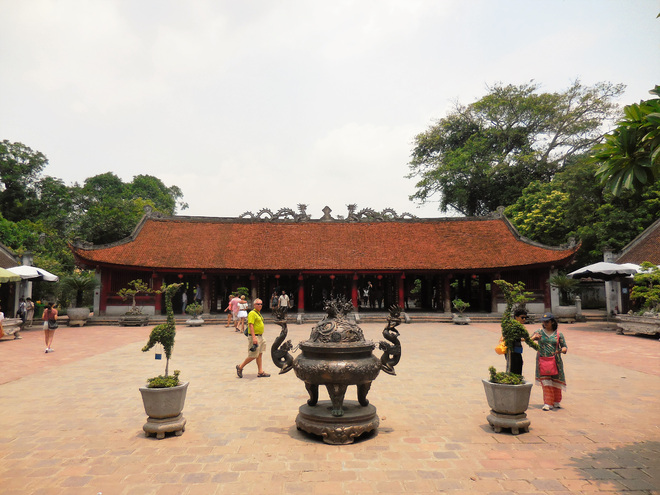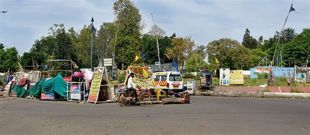
A courtyard at the Temple of Learning
Tanushree Podder
Vietnamese refer to it as the City of the Ascending Dragon. Long ago, sometime in the 11th century, King Ly Thai is fabled to have seen a golden dragon rising from the Hoan Kiem Lake. The vision moved the king so much that he shifted his capital to the lakeside. A fortress was built and the court settled there. 36 streets came up in the neighbouring area to cater to the needs of the kingdom. The city was called Thang Long.
The lake still remains as do the 36 Streets in the Old Quarter but the city’s name has changed to Hanoi. Much has changed since then. Hanoi has shed its communist past and adopted a path of rapid progress. The ravages of the long wars it fought with the invaders are being slowly erased. Its citizens are eager to catch up on the lost time. Hanoi, the capital of Vietnam, is a busy and bustling city. It is a quaint city with an Old Quarter, French Quarter and the outskirts. The Old Quarter, with its labyrinthine lanes, reflects the traditional lives of the locals. All one has to do is to walk its 36 Streets to get introduced to the quintessential Hanoi.
The streets are a cornucopia of creative treasure. These are named according to the business carried out there. There is Medicine Street, Silk Street, etc. each one with a prefix of Hang. For instance, Hang Cot is the Bamboo Street, where everything made with bamboo is available. Hang Non is for hats and Hang Dong for copper items. Rather like Chandni Chowk lanes. Cycles, mopeds and scooters swarm like ants in the main road while the streets are full of wayside eateries, where people slurp bowls of the national dish known as Pho (beef-enriched rice noodle soup).
The French Quarter is a contrast. With French architecture, colonial villas and tree flanked wide avenues, it is the area where the Indo-Chinese History Museum and Opera House stand. It is also where most luxury hotels, boutiques and shopping arcades are located.
Hoan Kiem Lake is the centrepiece of the city. Serene, atmospheric and beautiful, this is where the locals congregate each morning and evening to catch up with a spot of Tai Chi or a view of the sunset. Tired shoppers, romantic couples, frolicking children and senior citizens occupy the stone benches around the lake every evening.
With its past association with China, the Chinese influence over architecture, food and customs is very noticeable. The exquisite pagodas are a big draw with the visitors.
It is impossible to be at Hanoi and not say ‘Hello’ to Uncle Ho, as Ho Chi Minh is fondly known. Long queues at the mausoleum are an evidence of the popularity of the national hero, who is considered the father of Vietnamese nation.Inside the mausoleum lies the well-preserved body of Ho Chi Minh. The modest stilt house where he lived is a tourist attraction.
Right before the house lies a sprawling lake fringed with trees. It is said Uncle Ho came here every day to relax and rewind. He would clap and the fish would appear. Ho Chi Minh would then feed the fish. They would go back satisfied and he would return rejuvenated to his study to catch up the rest of his work. Encouraged by the story, many tourists try to lure the fish by clapping. The fish don’t oblige, of course.
The three-storey Presidential Palace, built in Indo-China style of architecture stands right across. The mustard yellow structure was used by the visiting dignitaries although Uncle Ho stayed in the unpretentious stilt house. Interestingly the pathway from the palace to the stilt house is lined with mango trees and is known as the Mango Alley. The One-Pillar Pagoda, Fine Arts Museum and Army Museum are within a stone’s throw away from the mausoleum. The Temple of Literature, which was founded in 1076 as the Imperial University and is listed as Vietnam’s first university. Exquisite pagodas, five lovely courtyards, temples, lake of literature and beautiful gardens make the place a restful treat for the senses. There are giant stone turtles with stone slabs at the back. Inscribed on the slabs are the names of those who passed out with highest grades. These are considered a symbol of good fortune and it is customary for local students to touch them for luck, before the exams.
Visiting the Hoa Lo prison is like travelling from serenity to horror. Known as Hanoi Hilton by the American airmen, it showcases the atrocities suffered by the Vietnamese during the French colonial regime. Exhibits include a metal guillotine that was responsible for many executions during that era. The hall that displays the life of US captives, with its packs of card, cutlery, books and chessboard shows a sharp contrast between the lives of the Vietnamese and the American prisoners.
As sun begins dipping, there is no better place than the Hoan Kiem Lake to watch it bid goodbye and rest the weary feet.
The best way to round off the day is by watching the famous water puppet show, an ancient Vietnamese art, which is performed at a theatre standing at one of the lake. The art of water puppetry originated in the 11th century and remains a popular entertainment to this day. Fire-breathing dragons, colourful fish, lively puppets tell stories from the traditional Vietnamese life to the accompaniment of the instrument known as Dan Bau. A commentary in the background enlivens the show.
Hanoi is not a place that can be covered in totality in a framework of a day or two. To do justice to the city would require at least a couple of weeks. The famous street food, arts and crafts, coffee culture and friendly people haunt the memories of visitors for a long time.
FACTFILE
How to reach: Many airlines like Vietnam Airways, Thai Airways, Singapore Airlines and Jet Airways fly from India to Hanoi
Where to stay: Vietnam is very affordable. However, the thumb rule is that the hotels in the Old Quarter are cheaper than those in the French Quarter. A five-star hotel like Hilton Hanoi Opera costs Rs 5,000 per night while a 2-3 star in the Old Quarter is just about Rs 800-1200 per night.
What to eat: Street food here is inexpensive. A cost of a bowl of Pho, which is rice noodle soup with beef, is a meal by itself and can cost as low as Rs 50, provided you are willing to sit on a plastic stool on the street-side and enjoy it with the locals. Sea food lovers will find the place a veritable paradise of offerings. Some of the must-haves are the famous Goi Cuon, bun cha, Cha Ca, Ca Mau, Com Tam and Vietnamese cold coffee.
What to shop: Silks, ceramics, black-and-red lacquer ware, woodcarvings and bamboo artefacts are some of the most popular shopping items. The local silk dress Ao Dai is a beauty. There are shops that can tailor it for you in 24 hours. Vietnamese coffee is famous globally as is green tea. Intricate paintings on silk are a local speciality. Bargaining is a must. Almost everyone haggles and to fantastic results.
Getting around: Cyclo (cycle rickshaw) is an easy way to cover the city. Beware, the cyclo drivers often ask for stupendous amount so bargain well and ensure the route. It is also possible to hire bicycles and pedal around the city.



























